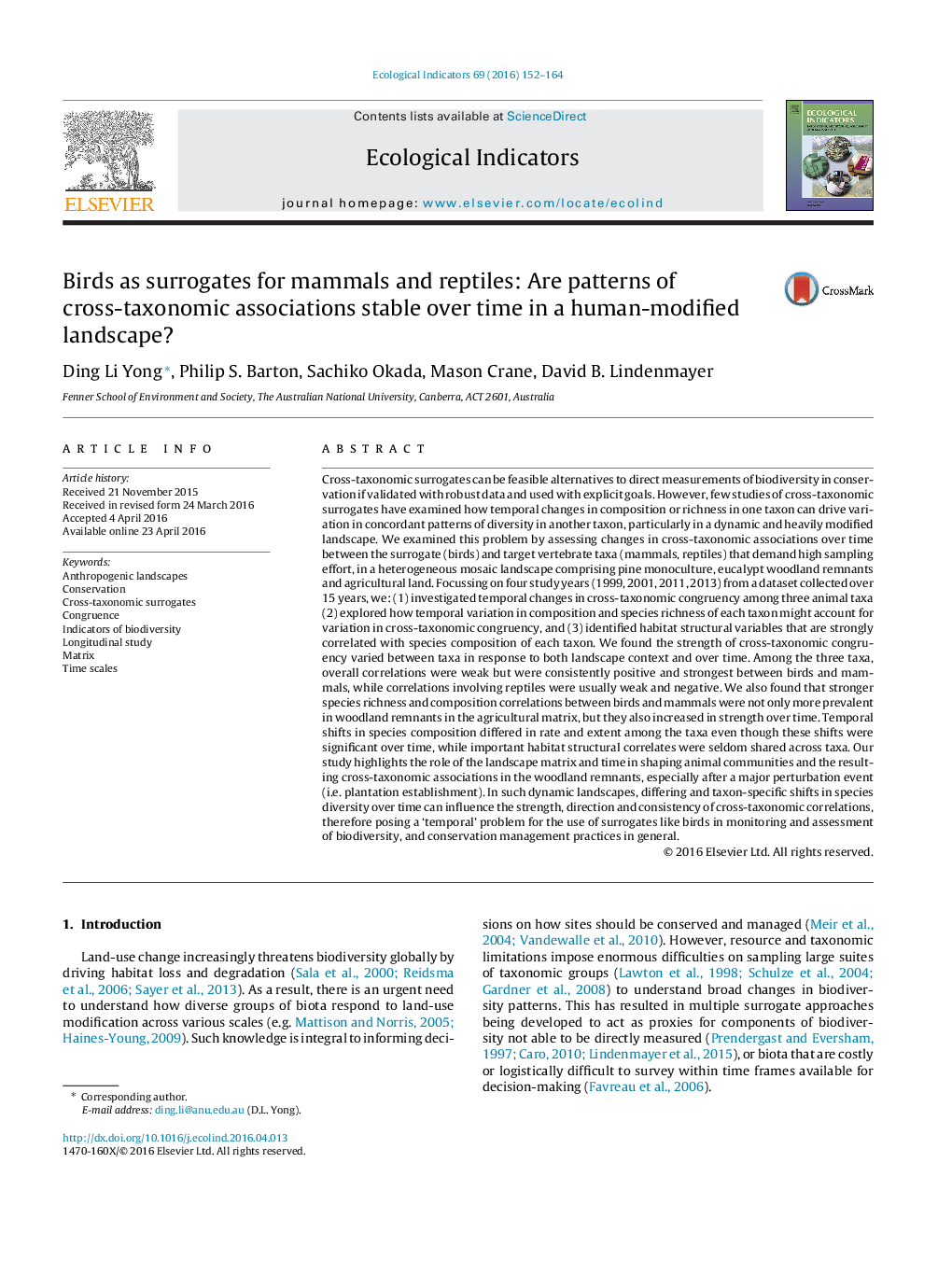| کد مقاله | کد نشریه | سال انتشار | مقاله انگلیسی | نسخه تمام متن |
|---|---|---|---|---|
| 6293203 | 1617133 | 2016 | 13 صفحه PDF | دانلود رایگان |
- One of few longitudinal studies (â¼15 years) examining cross-taxonomic surrogacy (bird, mammal, reptile) in a complex, human-modified landscape consisting of habitat patches (box-gum grassy woodland remnants).
- Congruency of species richness and composition between bird, mammal and reptile assemblages in woodland remnants differed between the landscape matrixes and varied over the study period, tending to increase in strength with time post-disturbance.
- Temporal turnover of species richness and composition of bird, mammal and reptile assemblages were taxon-specific, with stronger observed shifts for mammals and reptiles. Each of this taxon is correlated with mostly different habitat structural variables, with few shared variables.
- Ecologists applying cross-taxonomic surrogates in conservation assessments, monitoring and biodiversity inventories, need to consider natural history differences between the taxa examined, landscape contexts and the effects of community shifts over time, especially in newly disturbed landscapes.
Cross-taxonomic surrogates can be feasible alternatives to direct measurements of biodiversity in conservation if validated with robust data and used with explicit goals. However, few studies of cross-taxonomic surrogates have examined how temporal changes in composition or richness in one taxon can drive variation in concordant patterns of diversity in another taxon, particularly in a dynamic and heavily modified landscape. We examined this problem by assessing changes in cross-taxonomic associations over time between the surrogate (birds) and target vertebrate taxa (mammals, reptiles) that demand high sampling effort, in a heterogeneous mosaic landscape comprising pine monoculture, eucalypt woodland remnants and agricultural land. Focussing on four study years (1999, 2001, 2011, 2013) from a dataset spanning 15 years, we: (1) investigated temporal changes in cross-taxonomic congruency among three animal taxa, (2) explored how temporal variation in composition and species richness of each taxon might account for variation in cross-taxonomic congruency, and (3) identified habitat structural variables that are strongly correlated with species composition of each taxon. We found the strength of cross-taxonomic congruency varied between taxa in response to both landscape context and over time. Among the three taxa, overall correlations were weak but were consistently positive and strongest between birds and mammals, while correlations involving reptiles were usually weak and negative. We also found that stronger species richness and composition correlations between birds and mammals were not only more prevalent in woodland remnants in the agricultural matrix, but they also increased in strength over time. Temporal shifts in species composition differed in rate and extent among the taxa even though these changes were significant over time, while important habitat structural correlates were seldom shared across taxa. Our study highlights the role of the landscape matrix and time in shaping animal communities and the resulting cross-taxonomic associations in the woodland remnants, especially after a major perturbation event (i.e. plantation establishment). In such dynamic landscapes, differing and taxon-specific shifts in diversity over time can influence the strength, direction and consistency of cross-taxonomic correlations, therefore posing a 'temporal' problem for the use of surrogates like birds in monitoring and assessments of biodiversity, and conservation management practices.
Journal: Ecological Indicators - Volume 69, October 2016, Pages 152-164
